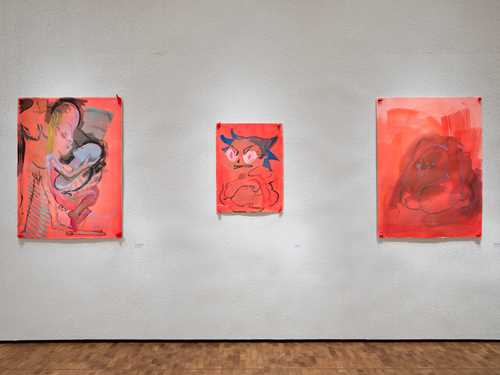Camille Henrot: Being and Becoming Human
Camille Henrot (b. 1978, France) received the Edvard Munch Art Award in 2015. As part of the prize, the recipient artist is given their own exhibition at MUNCH. In this essay, curator Tominga O’Donnell discusses their own meeting with Henrot’s artistic practice and the recent bodies of work represented in the exhibition Mouth to Mouth on the 9th floor of the museum (16.9.2022–26.02.2023).
‘Awesome’ is a word that people of my generation over-use to describe the most quotidian of events. I do remember thinking, though, that it was an appropriate word to describe Camille Henrot’s solo exhibition Days are Dogs at Paris’s Palais de Tokyo in 2017. Carte Blanche is an exhibition format that encourages the bombastic, as artists are given access to all of that venerable Parisian institution’s sprawling spaces.
It was a tour de force of artistic invention, range and ingenuity from what art world convention would describe as a young artist (she had not yet turned 40).
Here were early works like Deep Inside (2005) – featuring hand-drawn squiggles on an old 35mm amateur porn film – as well as her own films Saturday (2017) and Grosse Fatigue (2013), which was awarded the Silver Lion at the Venice Biennale. Here were Henrot’s works with Japanese flower arrangement, Is It Possible to be a Revolutionary and Like Flowers? (2012–19) and a room dedicated to her installation The Pale Fox (2014), which seemed to me to resemble a physical representation of the internet. Her huge bronze sculptures and frescos dominated the vast skylight spaces of Palais de Tokyo, and she had even installed a room full of gym mats to hold her bulbous aluminium sculptures that accompanied her film Tuesday with its close-up imagery of men wrestling.
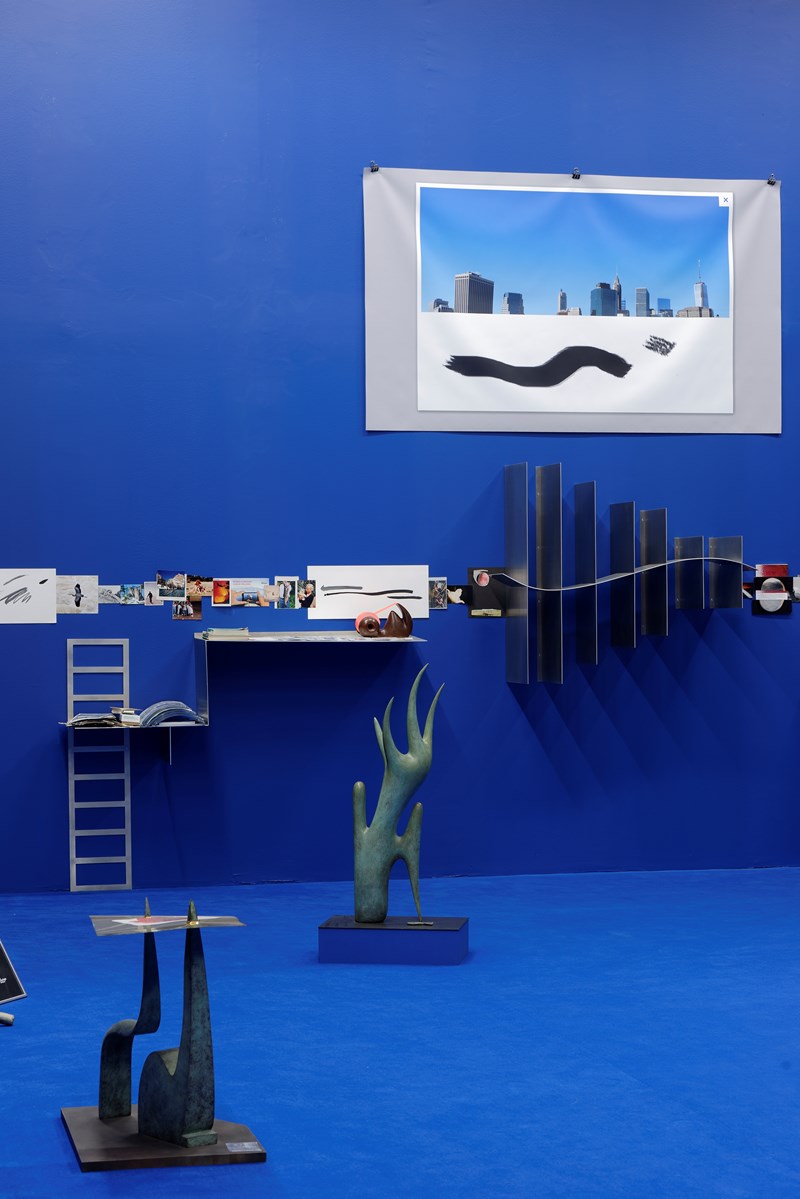
When I think back to this – effectively a retrospective exhibition – I am struck by the scale of not only the works themselves, but their ambition and scope. I remember walking through the galleries chuckling quietly to myself over the mischievous megalomania of it all. Earnest and cheeky at the same time. A towering intellect who was not afraid to be silly.
I remember thinking, ‘this woman has balls’.
It is telling that many of the words to describe this kind of muscular force are inextricably linked with the male anatomy. Boldness is ballsy, confidence is cocky and great achievements are seminal (from semen). I left with a profound sense of awe at what this artist was capable of.
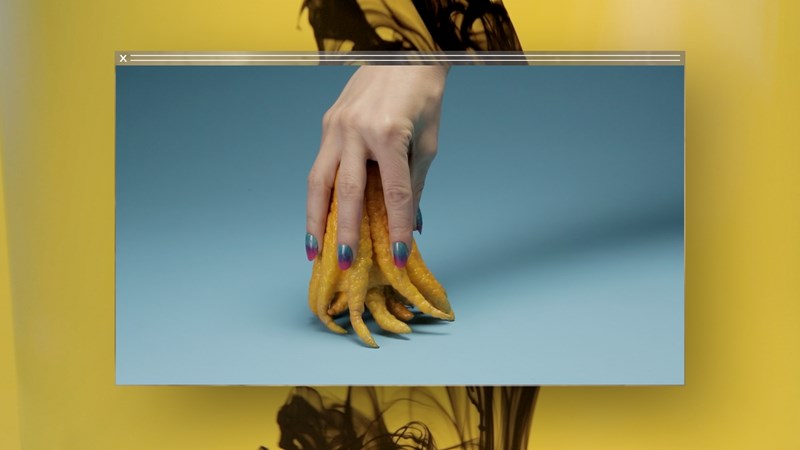
Camille Henrot, Grosse Fatigue, 2013 (film still). © ADAGP Camille Henrot. Courtesy of the artist, Silex Films and kamel mennour (Paris, London)
The exhibition in the two galleries on Level 9 at MUNCH consists predominantly of works on paper from Henrot’s System of Attachment series, created in 2019–21. There is some sculpture in this exhibition – two new bronzes, in fact, produced especially for Oslo. The emphasis, however, is on watercolours and the primal and primary relationships they sketch. They are more intimate than some of her earlier, large-scale watercolours (from the Bad Dad series, for instance), while at the same time addressing some of the most fundamental aspects of being in the world and the core relationships humans form with their surroundings and fellow creatures.
The MUNCH exhibition also includes new works from the series Dos and Don’ts, larger-scale collages that invoke elements from earlier works, such as the juxtaposition of computer browser windows and seemingly randomised images in Grosse Fatigue, or the black and white, almost sepia drawings of sonograms in the series Soon (2020). As always with Henrot, there is humour and playfulness throughout in both figuration and idiom. Her titles can be very funny and some of her imagery hilarious, despite the seriousness of the general subject matter.
Forming attachments
Until science manages to replace the womb, all human beings are born into this world from another human being who is invariably referred to as a mother, whether they identify as such or not. Regardless of how babies enter the world – via caesarean section or a so-called natural birth – there will be blood, gore and viscous fluids. At the beginning of Mouth to Mouth, Henrot evokes the birth canal in the initial felt-lined corridor that greets visitors to the gallery. The oil painting and watercolours shown in this darkened antechamber to the exhibition depict alien-like babies’ heads and symbiotic embraces in a palette of red, yellow and black. Blood is both alluded to and represented in titles like Rhesus positif, in which broad brushstrokes make it look as though blood has been literally smeared across the paper, retaining its pinky-red freshness. Watercolour as a technique allows for a retention of the brightness of liquid hues and an immediacy of application, whereas the oil paint dries much like platelets clot, offering another form of materiality in their surfaces.

Camille Henrot, Rhesus positif (2019). Watercolour on paper. Courtesy of the artist, kamel mennour and Hauser & Wirth. © Camille Henrot.
In terms of infant development, the pre-linguistic oral phase pervades this initial stage of the exhibition in which mouths dominate, whether gaping over the smaller head of another in Where do the words come from?, lips meeting between a child and a caregiver in Big Kiss or the delicate peck that one hybrid creature gives another in Little charm made of shell.
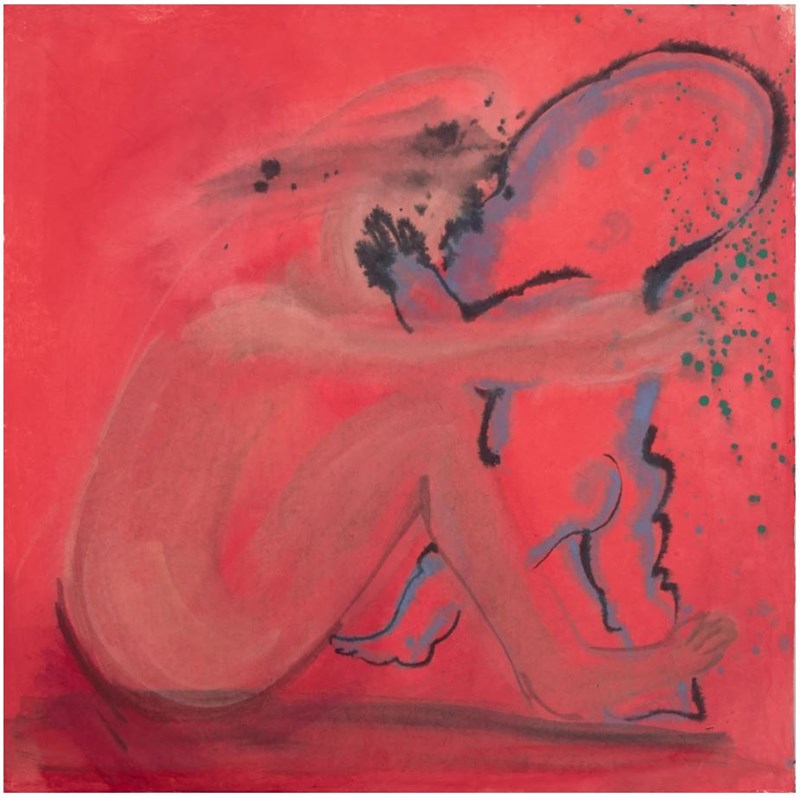
Camille Henrot, Big Kiss (2019). Watercolour on paper. Courtesy of the artist and Hauser & Wirth © Camille Henrot.
Human figures coexist with non-human beings, such as a cat nestled beneath a woman’s naked breast in How Clean is the Tongue that Just Kissed You. Strange hybrid creatures abound; Woman Interrupted, for example, appears more swan-like than human with her elongated neck. At the end of the corridor, the small oil painting Silent Words marks a transition where the two red faces it depicts are separated by a marked area of bright green. From the all-consuming, sometimes indistinguishable bodies earlier in the corridor, this work indicates a shift to a more distanced form of attachment. A move from an inexorable intermingling of flesh and bodily fluids to a more systematised, individualised being in the world.
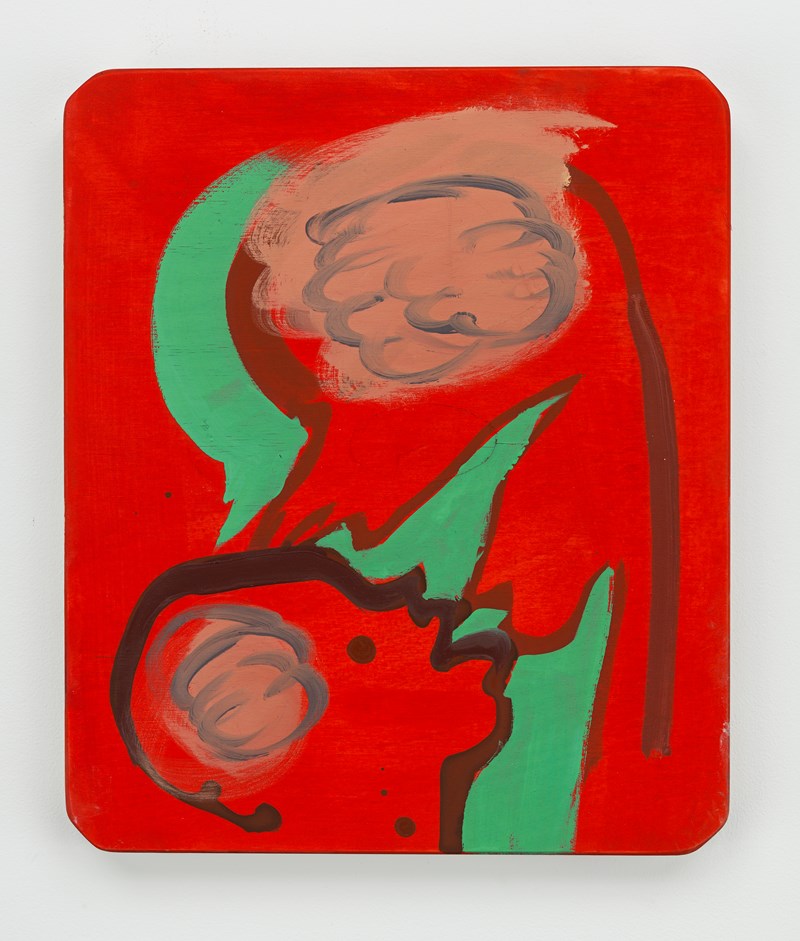
Camille Henrot, Silent Words (2020). Oil and acrylic on wood. Courtesy of the artist and Hauser & Wirth © Camille Henrot
Walls are never just walls in Camille Henrot’s exhibitions. They are, instead, backdrops, extensions of the works or cloaks around them. In the next phase of the exhibition, the brown felt gives way to a thick stucco on greyish walls. Close-up, it looks like some kind of extra-terrestrial or desert landscape. In the works in this section, other beings and objects enter the scene and the intimacy of the one-on-one relationship is refracted as the outside world encroaches. The gaze of the characters is occasionally directed out of the pictorial frame, confronting the viewer directly. The infant finds other things to play with and other characters infiltrate the intimate twosome first encountered in the felt-lined corridor. From a phase seemingly outside temporality, counting becomes part of the iconography as the baby grows, marking the passage of time – for the parent as much as for the child. The lines in S’il vous plait (Please) resemble the makeshift calendars made by cartoon prisoners, counting off the days until their release.
The complex symbiotic relationship between caregiver and infant is perhaps best represented in the Mother Tongue series, of which there are several on display in this exhibition, shown together on one long wall. The repetition of the same motif allows one to notice shifts in each image. The passage of time is also evident in these works as they allude to the myth of Cronos devouring his children for fear that they would usurp him. In Henrot’s entwined scene, it is unclear who is devouring whom. The baby is plump and the caregiver is haggard, clutching what Marguerite Duras referred to as ‘the monstrous burden’ of motherhood.[1] In her introduction to The Mother Reader, artist Moyra Davey writes that ‘much of life with small children revolves around loss of control and disintegration of physical boundaries’.[2] Davey has collected texts by other artists and writers who sustained her through the infant years with her child, including a range of ambiguous feelings and the ‘need for recognition of socially unsanctioned anger and frustration’.[3] In Mother Tongue, embracing the baby does not bring the serene pleasure that social convention and art-historical representations have promised, but are imbued with a sense of desperation – ‘a murderous alternation between bitter resentment and raw-edged nerves, and blissful gratification and tenderness’, as poet Adrienne Rich formulates it in her contribution to The Mother Reader.[4]
Together the diverse writings in Davey’s book point to a chasm between the notion of motherhood as it is propagated in patriarchal capitalist society and the actual lived experience of being a birth parent or primary caregiver. In her text ‘Anger and Tenderness’, Rich refers to her grown-up son’s comment that her diary entries from when he was a child showed that she set her aims too high for herself as a mother: ‘You seemed to feel you ought to love us all the time. But there is no human relationship where you love the other person at every moment. Yes, I tried to explain to him but women – above all, mothers, have been supposed to love that way’.[5] Motherhood is both a physical, biological and an invented system of attachment; as Rich puts it, it is both ‘an experience and an institution’.[6] It can be an exhausting experience, captured by Henrot’s watercolour Caffeine Awaits, where the parent is hunched over, leaning on one high-heeled boot, their blood seemingly only pumping in the lower part of their body and the rest a blur where broad black brushstrokes evoke a dissolution of the self for which coffee might provide temporary alleviation. Whereas physical exhaustion provides one restriction on primary caregivers, social policing provides its own set of limitations. In the way pregnant people are treated, one would presume that it was impossible to gestate anything other than a baby in those months – that one cannot be pregnant with ideas at the same time. Henrot’s triple belly in Look at us but do not touch offers a rebuke to such curtailment, and to those who assume that a visibly pregnant body becomes communal property, where the contours of the individual versus the public body are somehow erased.
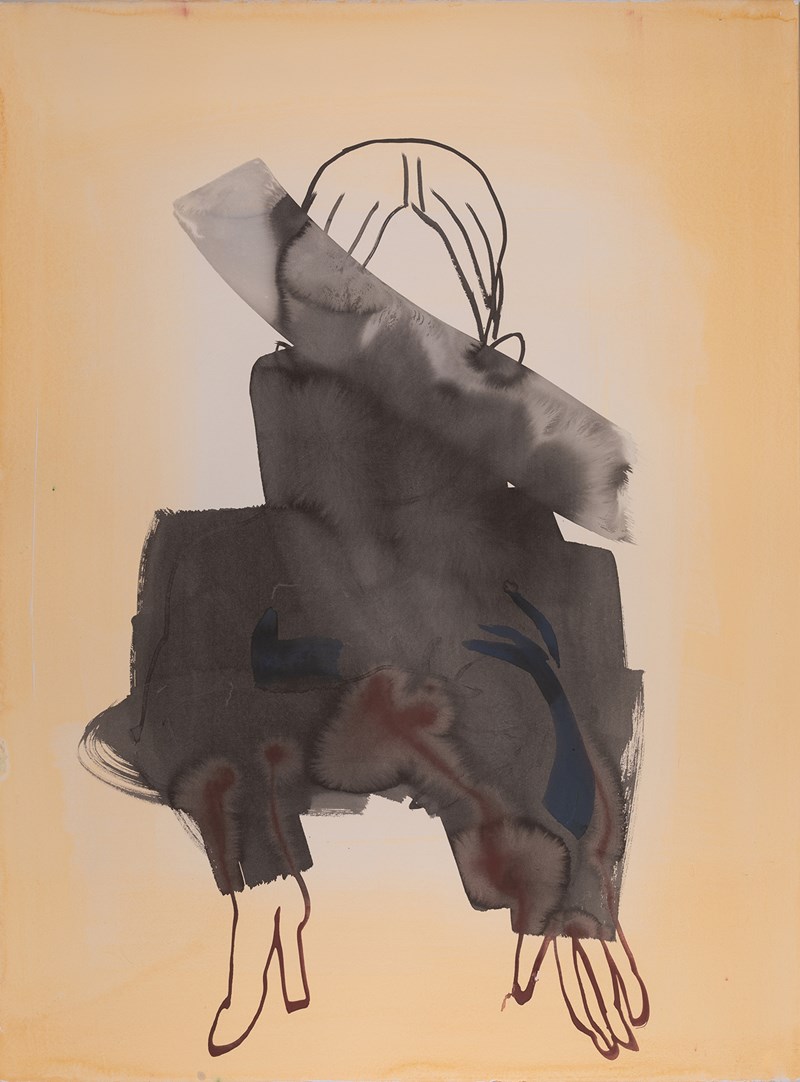
Camille Henrot, Caffeine awaits (2019). Watercolour on paper. Courtesy the artist and Hauser & Wirth ©Camille Henrot.
The title Mother Tongue refers to the colloquial term for the language of childhood, and this section of the exhibitions sees a shift from a pre-linguistic stage where the mouth is used to navigate and experience the world to one where words proliferate. The first work after the wall of Mother Tongue drawings is, in fact, an intertextual representation of the biblical story of Suzanne and the Old Men, which has been depicted by a range of artists, including Artemisia Gentilleschi and Rembrandt. Whereas the eponymous Suzanne is often presented as a bashful victim of the old men’s advances, Henrot gives her a more aggressive stance in which she removes her clothing only to slap her assailant on the head. It is a pose repeated in various works in the System of Attachment series, in the form of interactions between human beings that dwell on the push and pull of intimacy. In scenes of conflict, clothes are aggressively removed, yet revelation is denied, with broad patches of dark colour applied like a swift attempt at blurring out scenes of a sexual nature. These patches make it seem as if there is more to be seen here if one scrapes away the layers.
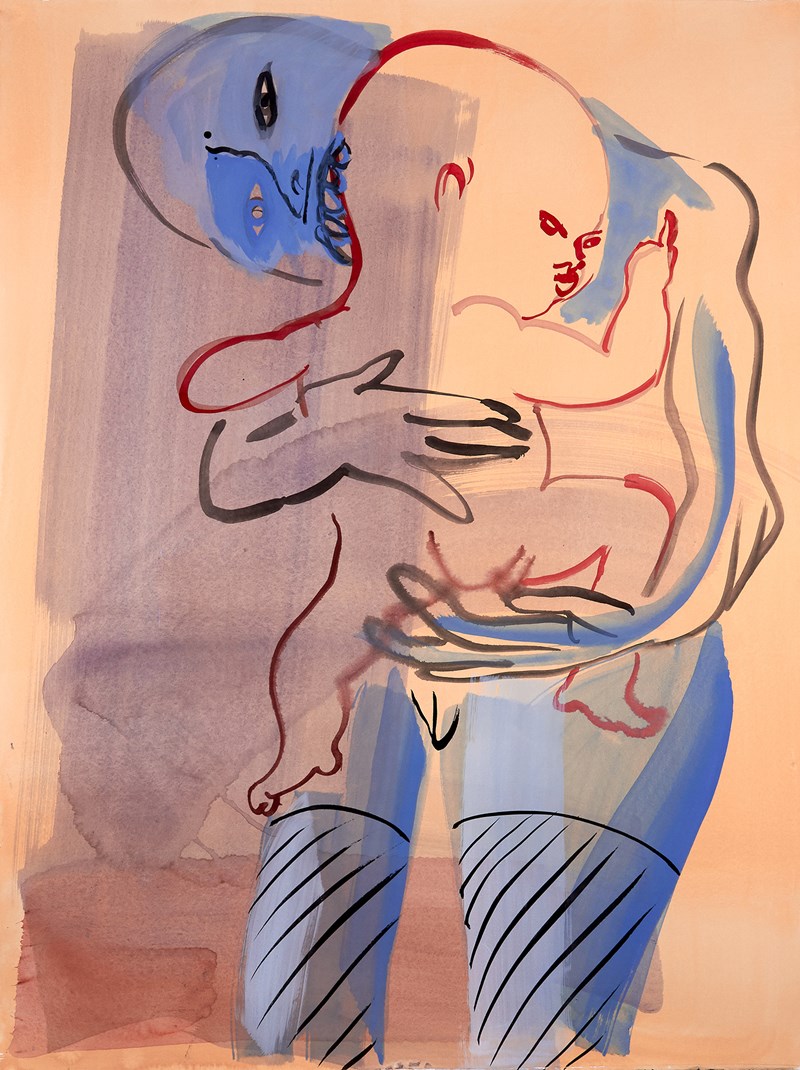
Camille Henrot, Mother Tongue (2019). Watercolour and ink on paper. Courtesy the artist and Hauser & Wirth © Camille Henrot
Skin forms a layer of the body that cannot be removed, but in Henrot’s universe one’s epidermis can be shed like a snake’s in Winter Skin. Idioms connected to this largest of human organs abound, whether in the notion of ‘shedding’ the burdens of one’s past, feeling ‘comfortable in your skin’ or the implied superficiality of something being ‘only skin deep’. The skin is also where touch lands, and this section of the exhibition shows a range of different kinds of touching: from aggressive clawing to a gentle caress. Rejecting chronology and a sense of progression from one kind of intimacy to another, from child to adulthood, embraces between parents and babies also feature in this section of the exhibition. They are all part of the ebb and flow of interpersonal and interspecies relationships, all contained in the same undulating landscape that surrounds them.
Codes of conduct
The stucco on the walls gives way to a smoother surface in the next stage of the exhibition, echoing the flat page of the book that inspired Henrot’s recent body of work, Dos and Don’ts (2021–22), as well as the computer screens they feature. The departure for this series was a book on etiquette the artist discovered in her grandmother’s house. From the vantage point of today, these late 19th century rules of behaviour seem like quaint tips for getting on in society, steeped in the same warped nostalgia that makes Downton Abbey a hit TV series. At the time, however, they were painfully aspirational. Etiquette was a clear marker of class, and a missed cue could spell social disaster – at least for those desperate to impress in unfamiliar circles. The market for such books was the middle class seeking upward social mobility (the working class wasn’t interested and the upper classes were there already). A true indicator of aristocracy was a flagrant disregard for the rules – knowing the codes and wilfully breaking them. In the eight collages that make up the display from Dos and Don’ts there are excerpts from two manuals of good manners in English and French from the late 1800s and late 1900s respectively.[7] The English entries are harsh in their condemnation of certain behaviours, which are deemed ‘irritating’ or ‘vulgar’. The tone of the English text is judgemental. It is not merely stating that one should avoid, for instance, ‘indiscriminate praise’, which is apparently ‘nauseating’, but adds rebuke without a reason – why is it nauseating? The tone, in fact, has more in common with a chastising parent or that internalised voice of self-loathing that exaggerates minor or even non-existent trespasses.
The juxtaposition of excerpts from the etiquette book with screen grabs from computers and mobile phones points to the multivalence of the term ‘code’. Where social codes govern live human interaction, computer programs also run on code. Both are binary at their core, as illustrated by the distinction between societal rules for men and women with separate instruction manuals – Mrs Humphry published both Manners for Men and Manners for Women in the same year of 1897 – and the zeroes and ones that lie at the heart of computer code. Yet, these two meanings of code rarely overlap. Indeed, the absence of social codes for the digital lives people increasingly lead is often cited as the cause of much online anguish, from the relatively minor infringement of ghosting – the digital equivalent to walking off mid-conversation – to the vitriol espoused by online trolling. As early as 1994, Virginia Shea published Netiquette for ‘cyberspace’, which has become a staple reference as various schools, universities and discussion forums attempt to implement some codes of online conduct. Shea’s first rule was to ‘remember the human’ at the other end of electronic communication.[8] Even though most people’s lives are a hybrid – never off-line so much as away-from-keyboard (AFK) to use Legacy Russell’s term – it seems that these two or more worlds are still considered separate when it comes to what is deemed acceptable interactive behaviour.[9]
The relationship between the digital and the analogue takes different forms in the Dos and Don’t’s series. The image subtitled My Bio shows an intimate family portrait of Henrot, her partner and their child. Broad brushstrokes partially obscures the familial scene as if it were excavated from behind layers of wallpaper. The pale pigment provides the grounding for a drawing of the coming member of the family, included as a fractured sonogram as if the foetus were an incomplete projection onto reality. Henrot has written about her series Soon – which resembles the drawing in My Bio and is rooted in her experience of ultrasonography – as being ambiguous images that make it difficult to distinguish ‘between abstraction and representation, the absence or presence of life’.[10] The foetus has a literal presence in the family portrait as growing inside its mother’s belly, but it has not yet taken shape in the outside world; only in the imagination of its closest family members. The months of waiting for the arrival of a new baby is fraught with expectation, captured in the term “expecting”, which is used to refer to the state of prospective parents in this period.
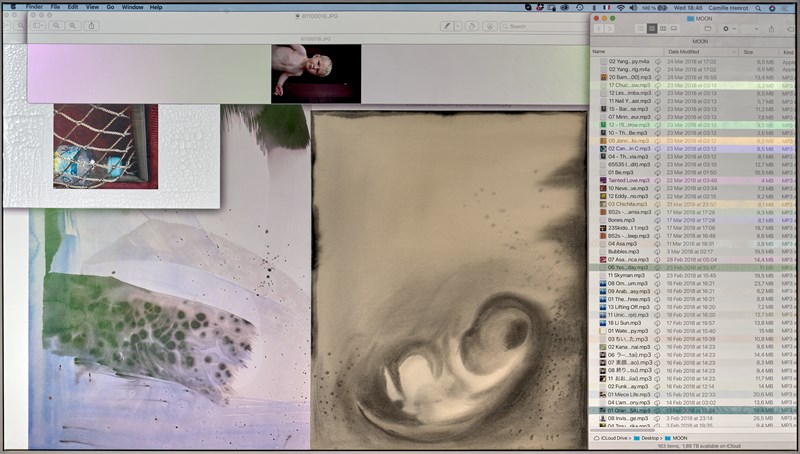
Camille Henrot, Dos and Don'ts – Cells (2022). Digital collage serigraph print with watercolour, ink, acrylic and oil on prepared canvas. Courtesy the artist and Hauser & Wirth ©Camille Henrot.
The collages are made up of an array of different imagery with different material qualities: flat family photographs, drawings of sonograms, thick squiggles of paint applied with piping bags usually used for cake decorating, photographs of cracked leftovers of paint from other works and screenshots of playlists and computer error messages: unreadable files and pop-up troubleshooting tips. I was once told that dreaming was the equivalent of the brain as a computer running through all its files in order to tidy them up, conflating important information with prosaic mess before expelling the useless leftovers. It sounded strange, but I quite liked the idea that bizarre, nightmarish visions were just a necessary part of bringing order to my ‘human hard drive’, deleting useless information to free up space for new memories and experiences. When it comes to actual computers, the process is known as defragmentation, but it is something I rarely do anymore with the seemingly infinite memory available in the terabytes offered to me there is no need to clear out the clutter. With cloud storage, everyone, in theory, has access to all their digital records, provided they can remember the passwords and still have access to recovery accounts. Infinite memory is dependent on memory of the memories.
Henrot moves seamlessly between analogue and digital references. Misfits, newly produced in 2022, departs from the familiar children’s sorting cube toy, designed to teach them about different shapes. Whether driven by nostalgia for a recognisable childhood toy or the fact that ‘a successful sculpture is one that triggers the urge to touch’ in Henrot’s words, the work engenders an urge to put the scattered shapes and objects in their matching holes.[11] Cracks and dents in the surface of the cube suggest that someone has already tried to place the wrong shape in the wrong hole. As such, it plays with the idiom of feeling like ‘a square peg in a round hole’, which is the opposite of ‘feeling comfortable in your skin’. Placed in the middle of Dos and Don’ts, Misfits points to the failure of meeting the expectations spelled out or alluded to in the collages that surround it.
Living together
The north gallery on Level 9 of MUNCH is host to another, far bigger new bronze sculpture by Henrot, Family of Men, which, like Misfits, also belongs to the System of Attachment series. This huge pile of creatures nestles up under the ceiling and dominates the dark-green space around it. It is loosely inspired by The Bremen Town Musicians, which was published by the Brothers Grimm in 1819 as part of their collection of fairy tales. In the story four animals, deemed surplus to requirements and doomed to be put down, escape to Bremen to become musicians. On the way, the donkey, dog, cat and cockerel encounter a house where a band of robbers reside. Standing on each other’s shoulders to peek into the house, the animals scare the inhabitants off and take up residency in the house to live out their days in happiness. The visual representation of the fairy tale is most often the four animals stacked up like a tower, which is how they are shown in a permanent outdoor bronze sculpture in Bremen. Its symbolism is subject to different interpretations: for some its stands for the power of the seemingly weak when they pull together; for others points to the importance of taking care of the old and frail that may have outlived their primary purpose in a society obsessed with productivity and profitability, as Simone de Beauvoir’s notes in her book Old Age.[12]
In Henrot’s sculpture, which bears only loose similarities with its Bremen counterpart, the creatures have multiplied to about a dozen and have taken on her characteristic human-animal hybrid form with beaks and eye sockets that suggest monocular vision. Together, they represent less of an organised collaborative effort than a chaotic mound of less-than comfortable individuals. The creatures at the bottom are flattened like cartoon characters whereas the only participant in the pile that seems vaguely at ease is the chubby one in the middle, sitting like a serene statue of Buddha with a beak. Even the one at the pinnacle of the sculpture seems burdened by the effort of getting there or perhaps by the weight of expectation placed on its tiny shoulders. It is a highly dysfunctional ‘family of men’ Henrot has depicted, seemingly seeking meaningless elevation. Its location in Oslo is poignant: not only is Edvard Munch’s sculpture and painting Menneskeberget: Mot lyset (The Human Mountain: Towards the Light) situated three floors down from Henrot’s exhibition, but one of Oslo’s primary sculptural landmarks has long been Gustav Vigeland’s Monolitten (The Monolith) situated in the centre of the Vigeland Park. Whereas the humans in Munch’s and Vigeland’s sculptures are clambering upwards – towards the light or towards the heavens above in some aspirational pursuit – Henrot’s Family of Men shuns the soaring and even sentimental verticality and appear to be regretting the whole venture. Samuel Beckett’s famous line of ‘try again, fail again, fail better’ from Worstward Ho (1983) springs to mind and alludes to the absurdity of human existence and the ultimate futility of attempts to get ahead.
A subversion of systems, hierarchies and institutions with the suffix ‘hood (motherhood, selfhood, nationhood) suffuses this whole exhibition, which to me, in its essence, is about boundaries – between the self and others, inside and outside, reality and socially-sanctioned idealism. In different ways, the works in Mouth to Mouth break down and mess up what it entails to be an individual, a parent, a lover or a human, displaying, in Moyra Davey’s words, ‘a willingness to viscerally engage with themes of disorder and disgust’.[13] That is, after all, the basic condition of being and becoming human.
The exhibition Camille Henrot – Mouth to Mouth is on display at MUNCH 16.09.2022 – 26.02.2023.
References
[1] Marguerite Duras, quoted by Tillie Olsen in Moyra Davey, The Mother Reader: Essential Writings on Motherhood (New York: Seven Stories Press, 2001), p. 110.
[2] Davey 2001, p. 18.
[3] Davey 2001, p. 16.
[4] Adrienne Rich in Davey 2001, p. 106.
[5] Davey 2001, p.106.
[6] Adrienne Rich, Of Woman Born – Motherhood as Experience and Institution (New York: Norton, 1976).
[7] Mrs Humphry, Manners for Women (London: James Bowden, 1897) and Nadine de Rothschild, Le bonheur de séduire, l'art de réussir: le savoir-vivre du XXIe siècle (Paris: Robert Laffont, 2001).
[8] Virginia Shea, Netiquette (San Rafael, CA: Albion Books, 1994).
[9] Legacy Russell, Glitch Feminism – a Manifesto (London: Verso Books, 2020).
[10] Camille Henrot, ‘Echo verse’ in Milkyways no. 3, REPUBLIK, 1 May 2021 https://www.republik.ch/2021/05/01/milkyways-echo-verse (accessed 10 July 2022).
[11] Camille Henrot, MEET THE ARTIST, Artspace online magazine (11 May 2021) https://www.artspace.com/magazine/interviews_features/meet_the_artist/i-attribute-a-lot-of-value-and-care-to-editions-and-i-really-enjoy-making-them-camille-henrot-56772 (Accessed 25 July 2022)
[12] Simone de Beauvoir, Old Age (London: Penguin, 1977/1970).
[13] Davey 2001, p. 18.
